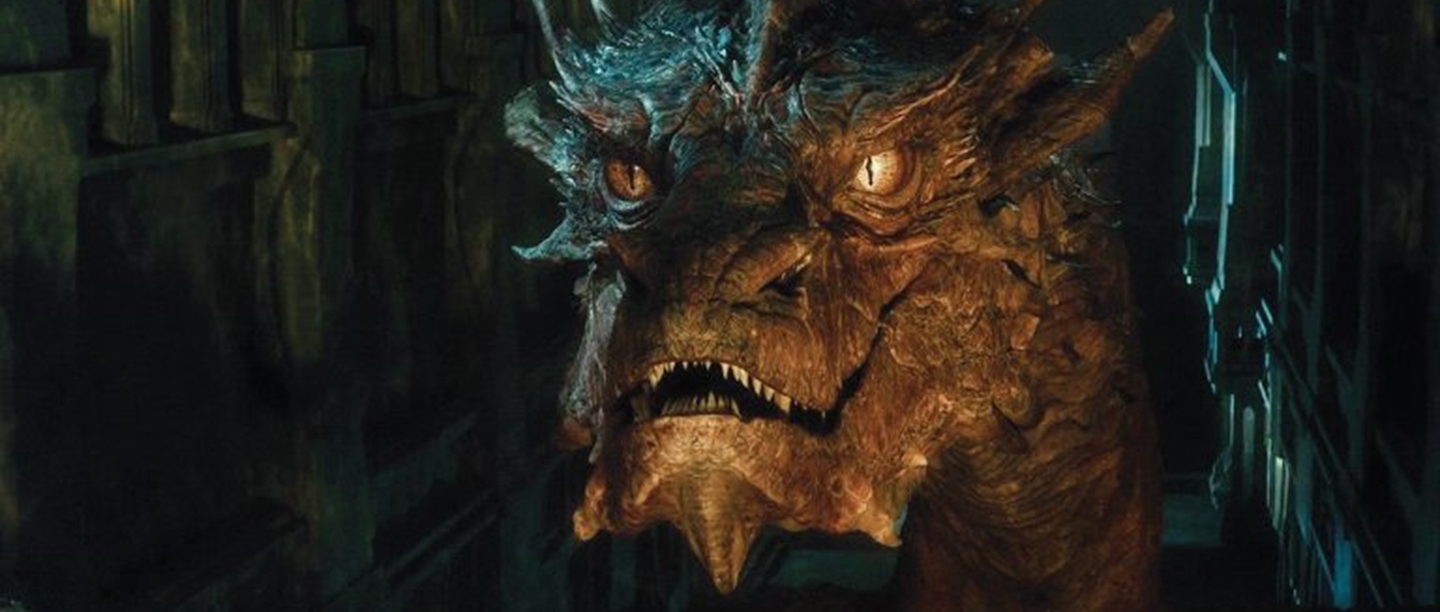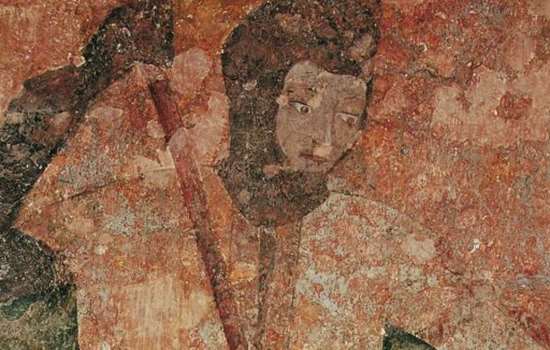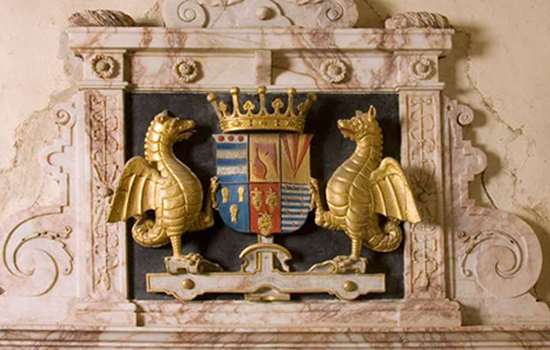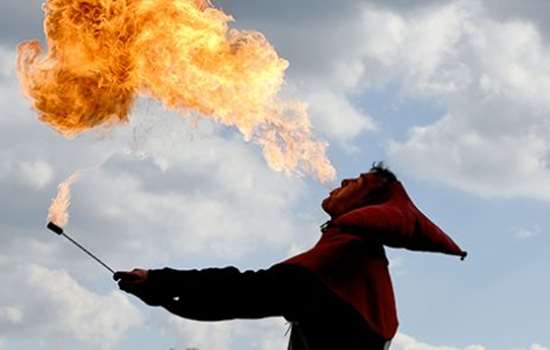
Where did the dragon myth originate, and why are dragon stories so widespread across at least two continents? Carolyne Larrington, Professor of medieval European literature at the University of Oxford, investigates.
Dragons feature in legend and folklore all across Britain, as well as Europe and Asia. They take many different forms and have varying characteristics: they can be a mild nuisance or a deadly peril; they may fly and breathe fire, or creep along spouting poison.
Various theories have been put forward to explain the popularity of the dragon legend. Recently it’s been suggested that the rainbow might have inspired tales of giant serpents. The Rainbow Serpent is indeed a creator-god in some Aboriginal Australian mythologies; when a rainbow appears in the sky, it’s said that the Serpent is moving between water-holes. Its capacity to find water is crucial to human survival in traditional societies, a function that connects it to the East Asian dragons. In fact, serpents are universally seen in the world’s major mythological cycles as having particular wisdom about the secrets that lie hidden beneath the earth’s surface. They can vanish into dark holes and reappear elsewhere, wriggling through the smallest chinks and crevices. Their habit of shedding their skins can signify the new knowledge they have acquired in the mysterious depths underground.
Indo-European legends, shared across Europe, the Near East and India, have a recurring story-pattern: that of the monster and the hero. In these tales, a fearsome monster, very often in serpent form, threatens human livelihoods by devouring animals and people – often young, marriageable girls. This provokes economic, political and population crises. The hero frequently needs supernatural help – a flying horse like Pegasus, or a magic sword – or he possesses superhuman strength, like the Greek hero Herakles (Hercules in Roman myth) who battled against the multi-headed Hydra in the marshes of Lerna. The monster is not always draconian in form, but it very often has serpent characteristics, perhaps dwelling in the sea, like the sea-monster that Perseus turns into stone with the aid of the Gorgon’s head when he rescued Andromeda. Or it may lurk deep within some rocky chasm like the Python, slain by the god Apollo with his arrows. This archetype symbolises the eternal battle between good and evil, but more specifically such stories are often used to explain how different peoples were able to move into new areas by conquering difficult territory and finding clever ways to overcome natural perils to make homes for themselves.
European dragons come in two kinds. The first is the northern, Germanic dragon that flies through the air on powerful wings and breathes fire when provoked. It loves gold and other kinds of treasure; where it finds a hidden hoard it moves in and sleeps on top of it. The fiery, flying dragon has been connected with the appearance of comets. The dragons that were seen flying over Northumbria in 793 (according to the Anglo-Saxon Chronicle) were most likely a comet of some kind, though they were interpreted at the time as presaging the ferocious attack of the Vikings on the monastery at Lindisfarne. The fire-drake is best known from literary sources, such as the Old English epic poem Beowulf, composed quite likely in the 8th century and written down in the early 11th century. This dragon found a treasure-hoard hidden in an ancient barrow and moved in. When a slave sneaked into the cave and stole a goblet, the enraged monster burned down Beowulf’s great hall and harried his people. The ageing hero went to fight the monster alone, armed with a special iron shield, but the monster seized his neck in its poisonous jaws. Beowulf’s kinsman Wiglaf hurried to help him, and together they slew the creature. Beowulf died of his injuries and had a splendid funeral. The dragon was tipped unceremoniously over a sea-cliff.
J.R.R. Tolkien drew on Beowulf when he imagined Smaug, the fiery dragon of The Hobbit, who took control of the dwarfs’ hoard. Tolkien added a detail from the most famous dragon of Old Norse legend – Fáfnir. This dragon also lies on a vast pile of treasure, one which, in the hands of the hero Sigurd who slays the monster, is later designated as the famous Rhine-gold. Fáfnir, like Tolkien’s Smaug, can also talk. The hero Sigurd fatally wounds Fáfnir, and the dying dragon warns him against treachery, communicates arcane mythological knowledge, and prophesies disaster for the hero if his counsel is not heeded.
Fortunately, these dangerous fire-drakes are quite rare. The most frequently encountered type of dragon in English folklore is the creeping and poisonous kind. It tends not to have wings, and it lurks in caves, marshes or fens. It devours cattle and maidens until a hero manages to dispatch it, or until a saint invokes the power of God to force it to move away. It’s been suggested that these dragon-stories may be connected with finds of dinosaur bones or fossils, or that the dragon’s lairs were situated near ancient battlefields, providing an explanation for the human bones that were ploughed up in the spring. But there doesn’t seem to be any particular correlation between dinosaur finds and local dragon legends, nor between battle sites and such tales. People tend to remember that battles occurred, even if they forget who was involved, and there’s no tendency to connect such finds with monstrous beasts.
The anthropologist David E. Jones has suggested that the dragon myth takes its origins from an innate fear of snakes, genetically encoded in humans from the time of our earliest differentiation from other primates. It is true, of course, that it makes evolutionary sense to avoid dangerous animals of every kind, but it is less clear why people should invent stories about imaginary oversized serpents in particular. Nevertheless, there is a clear benefit to tales that warn children against straying into perilous marshy areas where the serpent might seize them, or against scrambling up treacherous mountain sides in search of monsters and treasure hoards.
Some dragon tales account for geological features. The Orkneys and Shetland, along with the Faroe Islands, are the remains of the Mester Stoor Worm, a huge sea-dragon that would eat seven girls every Saturday. One day, a youth called Assipattle rowed out to meet him with some burning peat in a bucket. When the dragon swallowed up both boy and boat, the peat set fire to his liver. In his death agony he spewed out the hero, and where his teeth fell out across the North Atlantic they formed the island archipelagos. His body remains as Iceland, where his liver is still smouldering away, the cause of the island’s volcanic activity.
Medieval people may well have believed in dragons, in much the same way that they believed in lions and elephants. No one had ever seen one, but enough people knew someone who knew someone who had. Disease and miasma, which were particularly associated with marshes and fens, could be embodied as sinister, lurking creatures. Illness and its dragon-avatar could be dispelled through the power of a saint. One dragon who was terrorising the Somerset levels at Dunster was banished through the prayers of St Carantoc. Carantoc was the son of the king of Cardigan and had left Wales to lead a life as a holy man. Crossing the Severn estuary, his portable marble altar had fallen overboard. King Arthur had been trying in vain to deal with the dragon, and he enlisted Carantoc’s help after he found the altar miraculously floating on the river. Carantoc draped his priestly stole around the dragon’s neck and led him away where he could do no harm. Arthur rewarded him by building him a church at Carhampton where the marble altar was installed.
Most saints are peaceable and ill-equipped to go into battle against dragons, preferring to invoke the power of God to re-home the troublesome beast. Of course England’s national patron, St George, was a soldier-saint, courageous and fearless. George probably came from Cappadocia in Turkey. He is the patron saint of many other countries (including Georgia, named after him) and his legend recurs very widely. In English tradition his fight is said to have taken place at Dragon Hill, a low chalk tump, lying just below the Uffington White Horse in what is now South Oxfordshire. The dragon expected to eat the king’s daughter as he had devoured so many other noble girls, but George rode boldly against him and slew him with his shining sword. On Dragon Hill today you can see white spots of chalk through the turf, marking where the dragon’s poisonous blood spilled out, searing the grass.
The dragon is a strange creature then – it is monstrous, but also noble, and incorporated into many coats of arms. Indeed, the red dragon has come to symbolise Wales, after the battling dragons uncovered by Merlin. Most have been vanquished, whether by brave heroes or smart working men who figure out a technological solution to the local nuisance. Assipattle had his burning peat, More of More Hall killed the dragon of Wantley with a specially designed pointed-toe steel boot with which he delivered a fatal kick to the dragon’s tenderest portion: its bottom. But some dragons remain unfought and unrouted. There is one, apparently, that flies across the valley of the Exe in Devon from Dolbury Hill to Cadbury Castle every night, and another that lurks on his hoard under Wormelowe Barrow in Shropshire – as signalled by the monument’s name.
Although we can’t pin down the origins of these wonderful tales to any single phenomenon – dinosaur fossils, past massacres, rainbows, comets or volcanic activity – they speak to us still of the forces of nature, of greed and wickedness. And they promise that, if you’re smart and lucky, you might just win a dragon hoard of your own.
__________________________________________________________________________________________
Carolyne Larrington teaches medieval literature at the University of Oxford and researches widely into myths, legends and folklore, in particular in Old Norse-Icelandic and Arthurian literature. She is the author of The Land of the Green Man: A Journey through the Supernatural Landscapes of the British Isles (2015); Winter is Coming: The Medieval World of Game of Thrones (2015), and The Norse Myths (2017).



